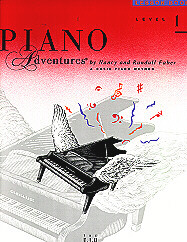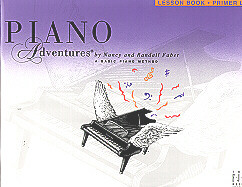Review of Faber and Faber Piano Adventures Basic Piano Method |
|||
he books by Nancy and Randall Faber are a popular and heavily promoted piano "method" with many adherents. They constitute a good starting point for a beginning teacher who has not had much in the way of piano pedagogy instruction or teaching experience. While the books have a number of strengths, they also have a disturbing weakness in the introduction of "position playing" early on. Moreover, from the standpoint of substance, the Faber and Faber "method" offers little that is fundamentally pedagogically new over methods that have been in existence for many years - like the Francis Clark, Louise Robyn and Suzuki methods. These other method books cost less and do more for the students than the Faber and Faber books.
|
|||
|
Concepts covered in the Primer Lesson Book include: Introduction to Playing with detail about sitting at the piano, hand positions, finger numbers, the directions of up and down on the piano, black and white keys; Basic Rhythms - such as quarter notes, half notes, whole notes, repeat sign, and basic dynamic concepts of forte and piano; and Key Names - ABCDEFG. Unfortunately, Middle C position is also introduced here. We think it would have been far better for the students to have kept the whole concept of position playing totally out of these books and, instead, stressed intervalic and individual note reading. Each page of all the books embodies delightful graphics, although my students found them to take up too much space on the page and to be largely unnecessary. There are good practice suggestions given for most of the materials such as counting aloud and holding the hands in a rounded position on the piano. A very good chapter is spent on Orientation to the Staff including the treble and bass clef, the grand staff, Middle C , Treble G, and Bass F. Middle CDEFG notes are introduced as steps on the staff, with pieces reinforcing new note names and earlier ideas. It includes Middle CBAGF notes in the bass clef, and 3/4 time signature, with pieces reinforcing new notes names and earlier concepts. The next unit deals with skips on the staff using pieces of music which incorporated skips of line to line or space to space, with more reinforcement of earlier ideas. The following unit deals with the concept of tied notes. The last section in this Primer lesson book deals with quarter rests and rhythm drills and uses pieces employing the quarter rest. The Technique and Artistry book for the Primer level enhances the concepts in the lesson book. We liked the child-friendly discussion about technique and the importance of having a good strong technique. This discussion was followed by a sound initial approach to piano technique - termed "Five Secrets of Piano Technique" including good posture (called the "Karate Pose"), rounded hand shape (termed "blooming flowers"), firm fingertips ("making o's"), art weight ("heavy wet ropes"), and correct thumb position. Each selection in the technique book incorporates the applicable technique secret and explains concisely and accurately how to incorporate the secret into each piece in the technique book The Performance book for the Primer level also, unfortunately, incorporated the position-playing approach. The students that did a test run of all of the pieces in this book enjoyed them, and found the duet part (that the teacher plays) to be delightful to perform with. The Theory book for the Primer level is concerned not only with sight reading skills but also with developing the listening and aural skills of the students. The same concepts from the lesson book are enforced in the theory book. Level One books cover concepts such as legato and staccato, the treble clef space notes, notes in treble c position (more position playing), intervals of 2nds, 3rd, 4ths, and 5ths (bravo), the half and whole rests, sharps and flats, tonic and dominant, the C chord, the V7 chord and finally G position. Also included are terms such as ritard, mezzoforte and mezzopiano. The technique book in Level One incorporates four more technique secrets, such as rounded hand shape (exemplified by hand cups), relaxed wrists (called "wrist float off" - done from a closed piano lid), light hand bounce ("woodpecker taps") and, finally, finger independence ("finger talk" - also done on a closed piano lid). Each piece in the technique and artistry book does exemplifies one or more of the secrets. Lesson Book, level 2A starts with a review of material covered in the previous books by having students take a review test and play a review piece of music. The seven units in Lesson Book eighth notes, transposition, the concept of the phrase, half steps and whole steps, D position, A position, and finally the minor -5 finger positions. Also covered in these units are the natural sign, crescendo and diminuendo, fermata, use of the damper pedal, and tempo markings such as allegro, moderato, and andante. As in the previous books there are practice suggestions and discovery items. While the concepts are presented in a manner that is pedagogically sound, Lesson Book Level 2A took about twice as long to get a concept across as other method books and relies more heavily than we would like on position playing, just as with the lower level books. All in all, the Faber and Faber beginning books can serve a teacher well who needs a pre-programmed series of books to follow as a starter for their teaching. The main pedagogical weakness of the Faber and Faber beginning books is their insistence on introducing position playing. Far too many transfer students who were previously taught position playing concepts cannot read music well and have to go back through the basics of note reading and recognition of intervals. This is not only frustrating for the teacher, but horribly frustrating for the student as well. Other methods exist that teach the same materials in 1 or 2 books, rather than requiring the student to purchase 4 or more books for each level to get all the concepts. For example, methods like the Clark cover the same material in one or two books that the Primer Level and the Level 1 in this method take 8 or more books to do. This ends up prolonging instruction needlessly for the student and teacher. Similarly, we would like to see students exposed to unvarnished beginning classical repertoire earlier than they are in these books. Although the design of the Faber and Faber series allows the teacher to "mix and match" books from the series with other piano method books or to use only selected volumes of the Faber and Faber books, doing so would be self-defeating in that the advantages of the integration of the books would be lost. We hope that future updates of this method will depend less heavily on position playing and consolidate the information in such a way as to make it more cost-effective. Piano Adventures (Primer Level, Level One, Level 2A), Basic Piano Method by Nancy and Randall Faber. Theory Book- Primer Level $5.95; Technique and Artistry Book- Primer Level $5.50; Performance Book- Primer Level $5.50; Lesson Book- Primer Level $6.50; Theory Book- Level 1 $5.50; Technique and Artistry Book- Level 1 $5.50; Performance Book - Level 1 $5.50; Lesson Book- Level 1 $6.50; Lesson Book - Level 2A $6.50. Published by the FJH Music Company Inc., 2525 Davie Road, Suite 360, Fort Lauderdale, FL 33317-7424. Ph: 1-800-262-8744 (USA) 1-800-457-8744 (Canada) Fax: 954-382-3073. WWW: http://www.fjhmusic.com/index.htm. E-mail: sales@fjhmusic.com |
||
|
Page
created: 9/6/99 Last updated: 02/09/24 |



 For this review, we bought and examined books from the Primer Level (Theory
Book, Technique and Artistry Book, Performance Book, Lesson Book), Level One (Theory
Book, Technique and Artistry Book, Performance Book, and Lesson Book) and Level 2A (Lesson
Book). The Faber and Faber books are cross-referenced to each other along the outer edge
of almost every page. For example, in the Primer lesson book, page 9 the following
cross-reference information is given: Performance Page 2, Theory, Page 4, Technique, Page
4,5.
For this review, we bought and examined books from the Primer Level (Theory
Book, Technique and Artistry Book, Performance Book, Lesson Book), Level One (Theory
Book, Technique and Artistry Book, Performance Book, and Lesson Book) and Level 2A (Lesson
Book). The Faber and Faber books are cross-referenced to each other along the outer edge
of almost every page. For example, in the Primer lesson book, page 9 the following
cross-reference information is given: Performance Page 2, Theory, Page 4, Technique, Page
4,5.